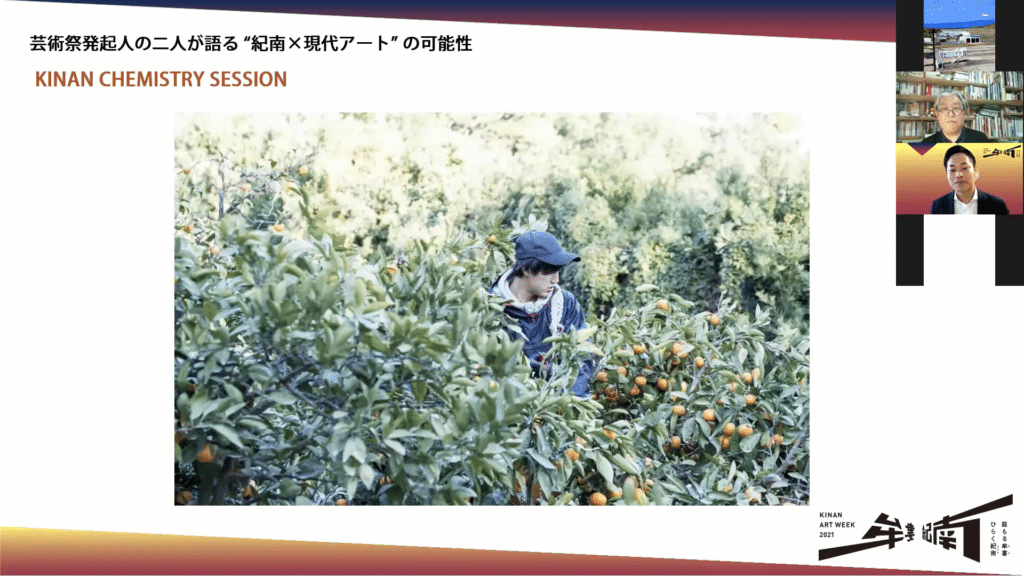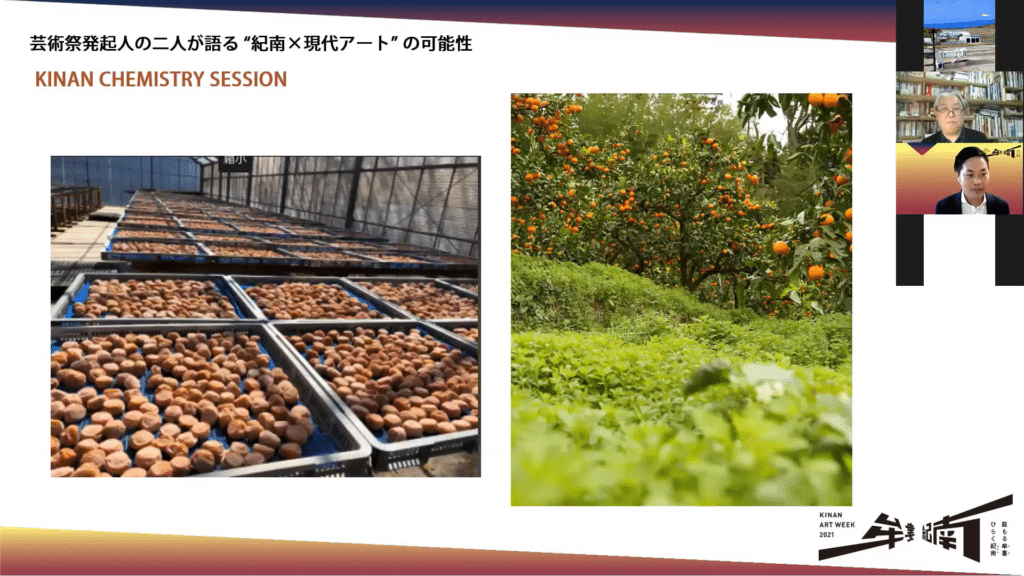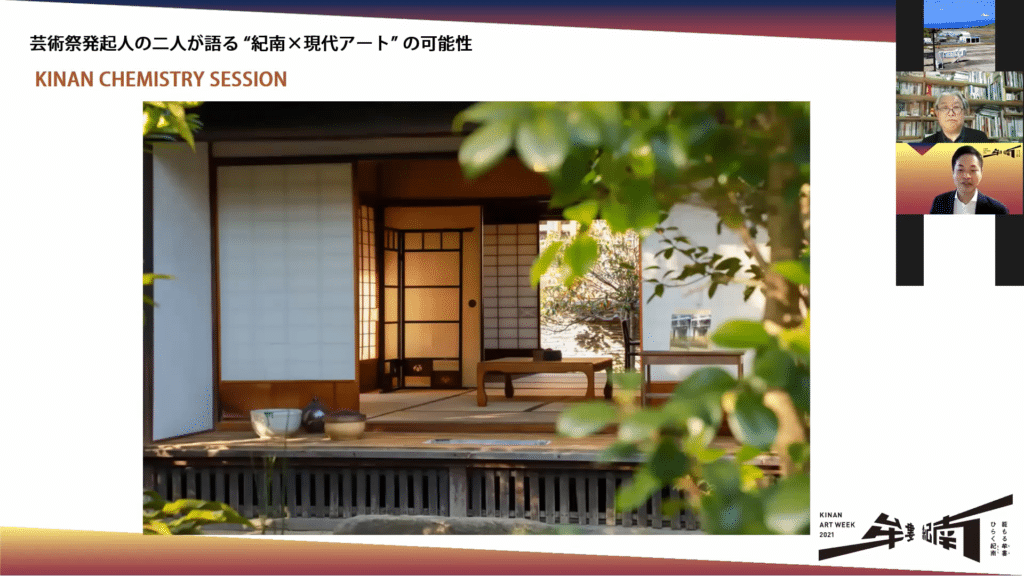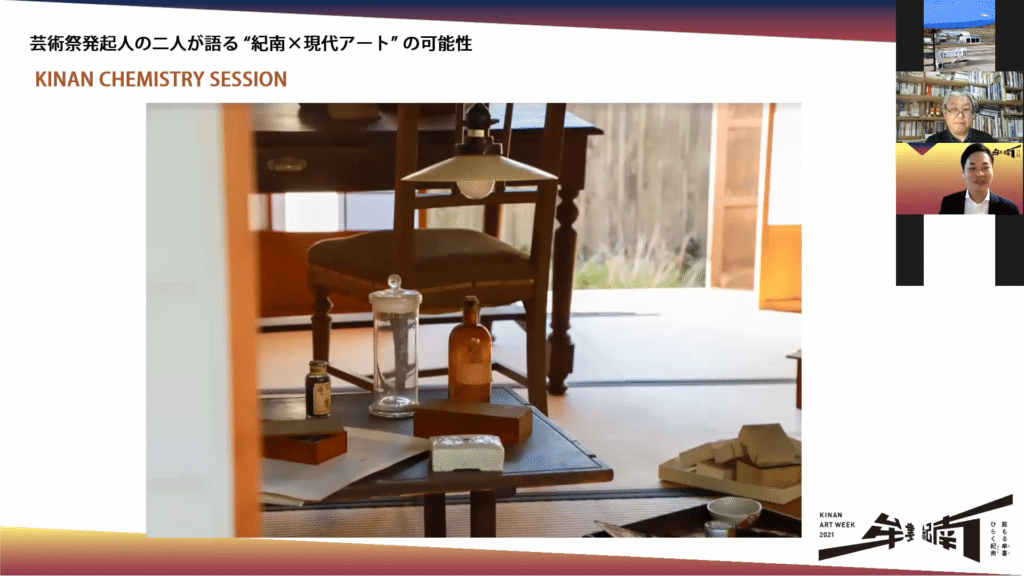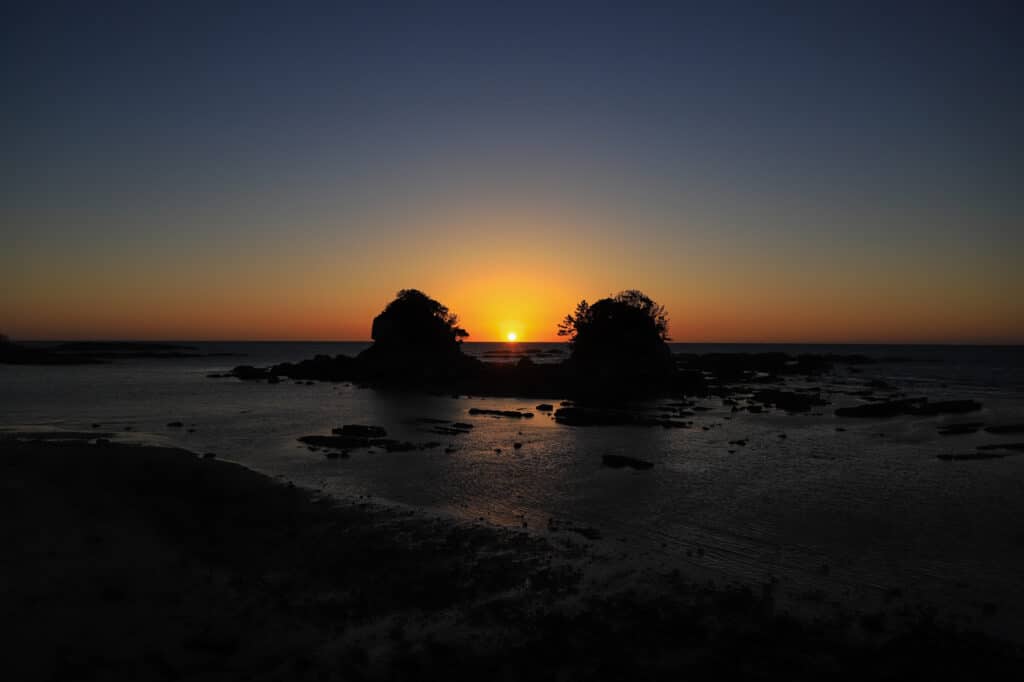Dialogue
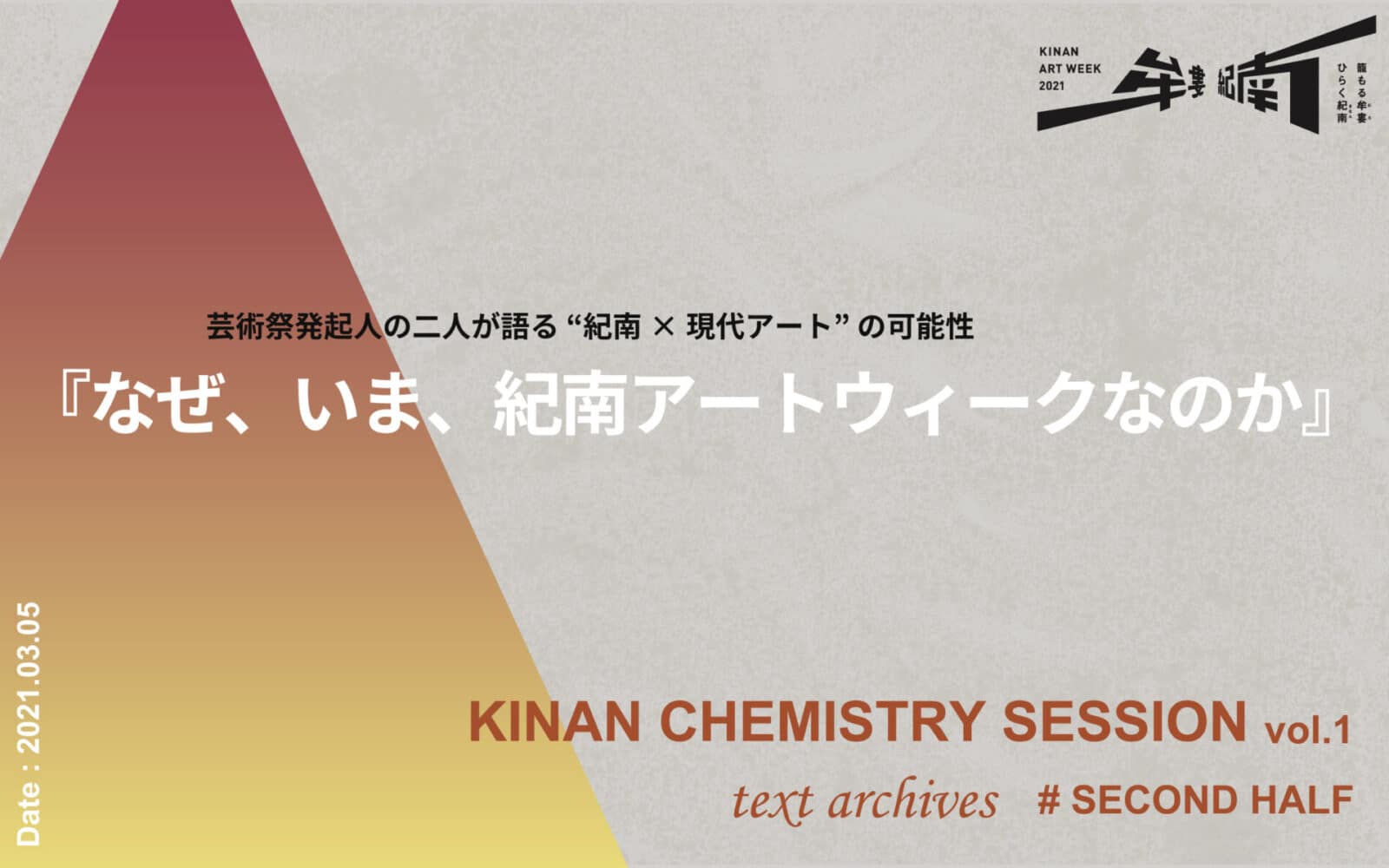
Archived Text (Second Half) of Kinan Chemistry Session vol.1 “Why Kinan Art Week?”
Online talk session “Kinan Chemistry Session vol.1” held on March 5, 2021
This is the second half of a text archive that transcribes an incandescent session.
*Click here for the text archive (First half)
https://kinan-art.jp/en/info/442/
*Click here for the video archive
https://kinan-art.jp/en/info/440/
.
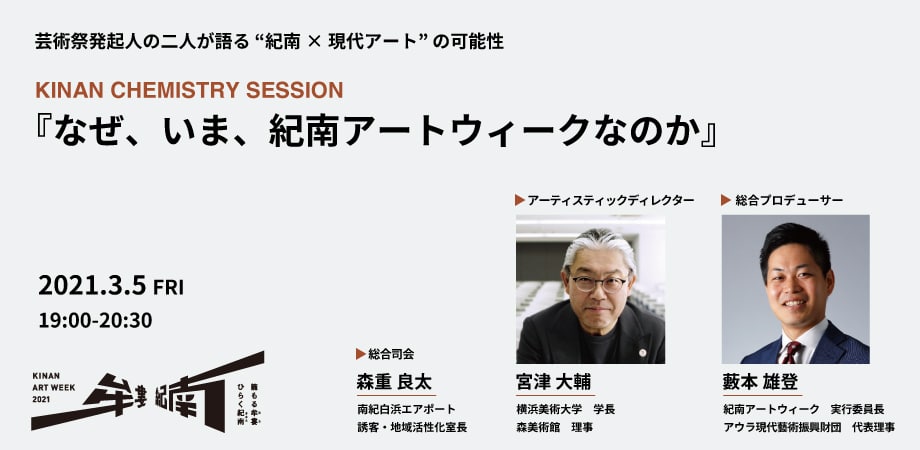
Title: “Why Kinan Art Week Now?”
Date and Time: Friday, March 5, 2021, 19:00 – 20:30
Venue: Online (ZOOM webinar)
Participation Fee: Free
Speakers: Miyatsu Daisuke (Artistic Director)
Yabumoto Yuto(General Producer)
Moderator: Morishige Ryota (Regional Activation Producer)
“Why Kinan Art Week Now?” (Second Half)
[ 3 ] What is the value of art?

Miyatsu:
Thank you very much, Mr.Yabumoto.
From here, I would like to start by explaining, as we mentioned earlier, how the Cambodian artist Khvay Samnang’s work has given you an idea of why art is a suitable means to bring out “seclusion” and “openness” as well as “the local” and “global” appeal of Kinan. So, why should it be an art week? Now, let me explain why it needs to be an art week and why it is art.
Visual art without translation
Miyatsu:
There are many kinds of art, but there are two characteristics.
First of all, there is visual art that does not require translation. For example, if we want to enjoy English literature, we basically read it translated into Japanese. Or, if we want to enjoy listening to opera, pop music or rock ‘n’ roll sung in French or English, we have to translate the lyrics or the words, but not the music or the melody. However, visual arts can be understood just by looking at them. The biggest thing about art in general, not just visual art, is that you can understand it as you see it. And if 100 people see it, there are 100 different ways of looking at it, 100 different ways of thinking about it, and every one of them is correct, which I think is one of the great aspects of visual art.
Hints for coexistence and co-prosperity with diverse values and others
Miyatsu:
The other characteristic is “hints towards coexistence and co-prosperity with diverse values and others”.
Contemporary art cannot be defined in a word: it can be art from the 1950s onwards, or it can be a reflection of contemporary thought or ideas. It can be described in many different ways, but there is no firm definition. But the reason why we call it contemporary art is that in English, ‘contemporary art’ is actually a translated word. ‘Gendai-Bijytsu’ (Contemporary art) is the same, but the word ‘bijyutu (art)’ itself was originally created in Japan by translating a foreign word from the Meiji era, so it is a young word in Japan. In English, it’s called ‘contemporary art’, and the word ‘contemporary’ can mean both ‘contemporary’ and ‘contemporaneity’. In other words, art that is merely made in the present time is not contemporary art.
Perhaps the true contemporary art is that only things that were created naturally with a suitable reason for that era and things that have ‘contemporaneity’. In that case, it should reflect the contemporaneity, the Japanese for the Japanese, the French for the French, men and women, young people and seniors, transgender people, various environments, the state of the world, and so on.
So why is this a good match for Kinan Art Week? Take a look at these four paintings.
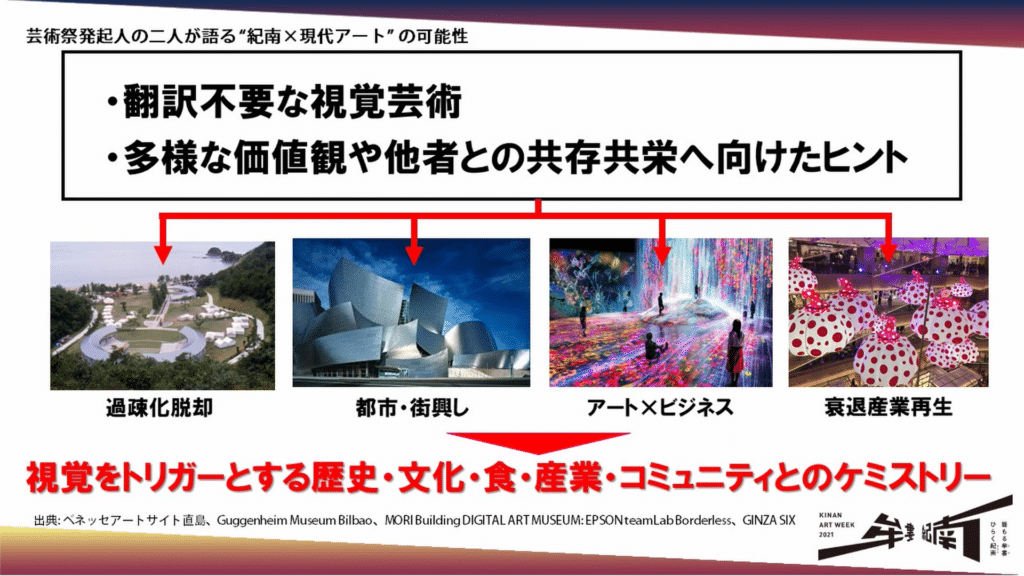
Miyatsu:
On the far left is an island called Naoshima in the Seto Inland Sea.
This is Benesse Art Site Naoshima, which was created by the Benesse Group with private funds. Naoshima, Teshima, Inujima, and other islands were created as a major art facility, a program to enjoy nature and art, like the Setouchi International Art Festival, or museums.
What this has done is to take islands where industrial waste was illegally dumped, islands where copper smelting had left barren mountains, and small islands in the Seto Inland Sea where only the elderly lived and depopulate, and turn them into islands that attract tourists from all over the world. It has also created jobs, attracted young people to the islands, and given vitality to the elderly.
The second building from the left, which looks like a mirror and doesn’t look like a building at all, is a museum in the city of Bilbao in Spain, in the Basque Autonomous Community.
It is a branch of the Guggenheim Museum in New York, which was built by Frank Lloyd Wright. It is designed by Frank Gehry and was opened with a large piece of art that was too big to exhibit at the Guggenheim Mueum in New York. In such a unique looking museum building that does not totally look like a building.
A desolate Basque city, where the shipbuilding industry has died out, where the tendency towards independence is so high, and where terrorism is rife, has now been transformed into one of Spain’s leading tourist cities. Just a single museum is the great catalyst for this transformation.
Next to it, which is a TeamLab work, there is a new museum in Odaiba with a permanent TeamLab exhibition. In less than a year, 2.3 million people have visited the museum, 60% of them from all over the world.
This one museum has transformed Odaiba, and people from all over the world are coming to see new art using unique Japanese technology, to see new aspects of Japanese technology and culture, and to share it with the world through social media.
On the far right is Ginza Six, a new shopping mall built on the site of the former Matsuzakaya department store.
This is a large sculpture by Yayoi Kusama, and every few months they display this kind of art work in the central atrium of the mall. This has revived the department store industry, which unfortunately was on the decline. At the same time, when Louis Vuitton collaborates with Takashi Murakami and Yayoi Kusama, it’s a way of joining forces with art to transform fashion, which is something that dies after one season, into something that has a long life.
Art has the power to give new life to an industry or an economic activity that is in decline or has some problems.
I have told you about some of these success stories, but not all of them will work because of the use of art. However, triggered by visual art which does not need translation and offers 100 perspectives for 100 people, by combining art with the history, culture, food, traditional industry and local community that Kinan is famous for, we can create a great chemical reaction there.
In the past, we used to export our products to Japan and the world, by ship from Tonda Port, but today Tonda Port is Nanki Shirahama Airport, which is cooperating with us this time. We hope that we can use art as a means to turn the wonderful things of Wakayama from local to global.
Why contemporary art?
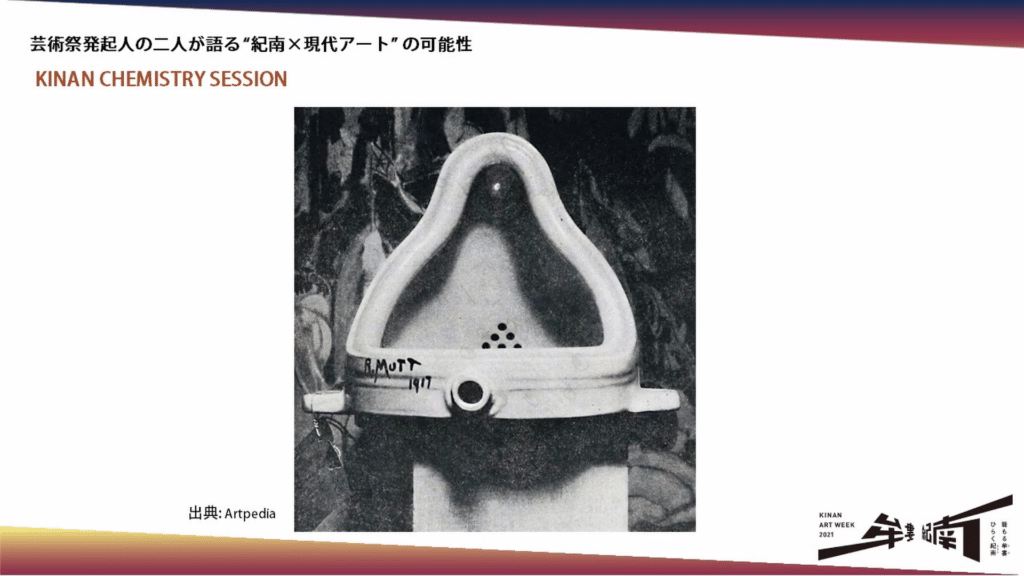
Miyatsu:
Let me tell you a bit more about art and why it is contemporary art.
This is a work of art made in 1917 by a French artist called Marcel Duchamp.
It’s called “The Fountain” and it’s actually just a man’s urinal on its side. This is the origin of contemporary art. The reason is that he didn’t make anything, he just put his signature on the toilet bowl. The reason why this work is contemporary art is that the moment it is put in a gallery or a museum, when you meet it, you think: “This looks like a toilet bowl, but maybe it is valuable, expensive and precious. It is said that the purpose of this work is to reveal the particularity and privilege of the space of the gallery or museum by bringing this work, this toilet bowl.
This is exactly what I was talking about earlier, the contemporaneity of contemporary art and the simple visual presentation of problems.
This is what the best contemporary artists, from Duchamp to Samnang, have shown us in their works, and by exhibiting these works in a unique and wonderful place in Kinan, the power of the place, the local people and contemporary art will combine to create a greater power! This is what we want to demonstrate at Kinan Art Week.
What is the definition of art?
Yabumoto:
Let me ask one question, what is your definition of art, Miyatus-san?
I am now interested in how art should be defined. I said earlier that I was impressed by Samnang’s work, but I think that the so-called Western definition of art is very narrow and is more focused on technical theory. I think that the definition of art should be broadened, and that if you are moved by a work of art, it is art, and in that sense, not only artists, but also businessmen, farmers, lawyers, doctors, prime ministers, should all be called artists. What do you think about this?
Miyatsu:
I myself am a collector and an educator, so I think that the word ‘art’ can be translated into Japanese as ‘芸術(geijyutu)’. But when you ask what ‘geijyutu’ is, there are many ways of understanding it. This is where it is difficult to interpret Japanese and English. For example, something that impresses or moves people has characteristics that evoke a strong impression that is different from other things, or it has a different appeal or a different perspective that other people take for granted and miss. Therefore, I think there is some debate as to whether we should call it ‘art’, ‘geijyutu’ or ‘creativity’.
Also, as Mr. Yabumoto said, there is no big difference between ‘geijyutu’ that moves people and ‘geijyutu’ that has creativity. In the case of contemporary art, whether it is a work of art or an outstanding and innovative piece of business or game is probably determined by one’s point of view. It’s a bit like “seclusion” and “openness”, but if you turn around and look at it one more time, you’ll notice that they’re right next to each other.
Why is art so valuable?
Yabumoto:
Thank you very much.
One more thing, I think that people perceive that art and contemporary art are very expensive, but why is the value of art so high? This is my own hypothesis. However, for example, when I talk to Samnang, I wonder how high is their original value linked to the high perceived or real value of art. I think Samnang is asserting the Cambodian worldview that was originally there (that we all want to get along with our families and have fun in a beautiful environment).
I think that’s a very universal thing. I think the value of the work that comes out of those universal values will also be high. What do you think about that?
Miyatsu:
I don’t think there is a big difference.
To put it a little more clearly, as I mentioned earlier about contemporary art, Leonardo da Vinci also created contemporary art in the 1500s, but over 500 years later, he has become a classic. Impressionism was also very innovative at the time, but in the 21st century, it is no longer contemporary, but it’s now ‘modern art’.
In other words, a work of art that is both outstanding and contemporaneous with its time will always outlive its time by several hundred years and become a classic. Therefore, the higher the value of contemporary art works, the higher the probability that it will increase in value later. However, if there is a belief that in 100 and 2000 years, its universal importance still remains, and there are some strong suggestions to people of the future perspective, it means they are high value even now. One of the things that can express that value is money, and the earlier you realize that, the cheaper you can buy it. So, when I bought the first Samnang, it was a few hundred thousand, but when Mr. Yabumoto bought it, I think it would have been much more expensive.
Yabumoto:
Yes, it’s true, it’s different.
Miyatsu:
That’s what I mean when I say that the value is going up. If you buy a Leonardo da Vinci now, it’s worth tens of billions.
What does it mean to collect art?
Yabumoto:
I see.
I would like to ask you one more question. What does it mean to keep or collect art? I would like to hear from you as a collector.
Miyatsu:
I think it’s different for each person, but the reason why I collect is that now I am a scholar and an educator, but at that time I was a businessman, so naturally I didn’t have a lot of money. I find things that people don’t know about, and there are wonderful things in them, and by paying for the work of people who are not yet famous, I am paying them enough money to pay for the materials for their next work, if not to support their lives, to pay for food for a week, to pay for their families. This is important to me, and if they become successful like Samnang, the money they earn abroad will be used to train young local artists and curators.
At the beginning of a big food chain, strangely enough, it is not always the people with money who are able to identify the great things, so if I keep my sense of smell high, I will be able to buy into the work at a time when artists are struggling to eat, which will enrich my collection, and at the same time, it helps the artists to continue their careers and make them successful, which I think is the main point.
What does it mean to “buy the ideas of a genius”?
Yabumoto:
Thank you very much.
Another thing that really sticks in my mind is the phrase “buying the ideas of geniuses”. Learning from an artist who has crazy or fantastical ideas is so meaningful even if only slightly. I believe it’s a wonderful thing that can’t be exchanged for money. That’s same as learning and moving.
Miyatsu:
I think money is important because everyone needs it, and it’s like paying an entrance fee for the ideas of a genius. Seeing pandas at Adventure World, or watching a great orca show, is worth thousands of yen. I think it’s probably the same here. You can pay hundreds of thousands, millions, or even hundreds of millions of yen to buy the ideas of a genius.
[ 4 ] The uniqueness of Kinan Art Week

Miyatsu:
Now that we have talked about the value of art, can you tell us what is the difference between Kinan Art Week and the many other art festivals that exist throughout Japan?
Yabumoto:
Certainly.
My main business is mostly dealing with infrastructure export projects. I have worked with Japanese general contractors and trading companies on many infrastructure projects, especially in the Asia-Pacific region, such as airports, electricity, roads, water, sewage and railways. As my father is a construction equipment manufacturer, I have a great affinity with engineers and old men in the construction industry, and I have been supporting them. In the process, I have often wondered whether Japan’s infrastructure exports are really competitive. In this sense, I have been thinking about what I can do to help Japan’s infrastructure exports. I think that valuable infrastructure, like art, is something that people all over the world want to use, buy and access, no matter how expensive it is.
An airport-based arts festival
Yabumoto:
So we studied Singapore Changi Airport.
Changi Airport earns relatively well from non-aeronautical activities. They get management fees for taking off and landing planes, but they also use Changi Airport as a hub airport, so that people from all over the world can come and go. With arts and entertainment as the core, the tenant business is very well developed.
I thought that Japanese airports should learn from this, so I have been working on various projects. Then I talked to Mr. Miyatsu and he told me that he had been working with the committee on art and airports for a long time, and that’s how it all started.
Miyatsu:
Yes, that’s right. Actually, before the COVID-19 pandemic, I used to give a lecture every weekend whenever the autumn art high season comes, not in Japan, but in Asian countries. In places like Changi Airport, which Mr. Yabumoto mentioned, or Incheon Airport in Korea, you can see the huge entertainment complex there. In other words, from the concerts of Korean stars to the clubs of world-famous DJs, from the works of world-famous artists such as Yayoi Kusama and Damien Hirst, from luxurious boutiques to luxury hotels, all in a paradise city with casinos.
When I saw Changi, Incheon and other airports, I wondered how Japan’s airports and the region around them would be received by the rest of the world. We have to get as many flights as possible, and where are the flights routes of Asia that fly to Europe and America? Is it Incheon, Beijing, or Japan? Beijing is also building a huge airport. What will happen to Japan when the new airports in Asia are getting bigger and bigger?
I was a member of the committee for Haneda and Narita airports, but I was not able to make my recommendations come to fruition. Through this experience, by all means, I want to create successful cases in Wakayama Prefecture and Kinan area, and now I am also working on ‘art’ and ‘airport’ with a very passionate desire.
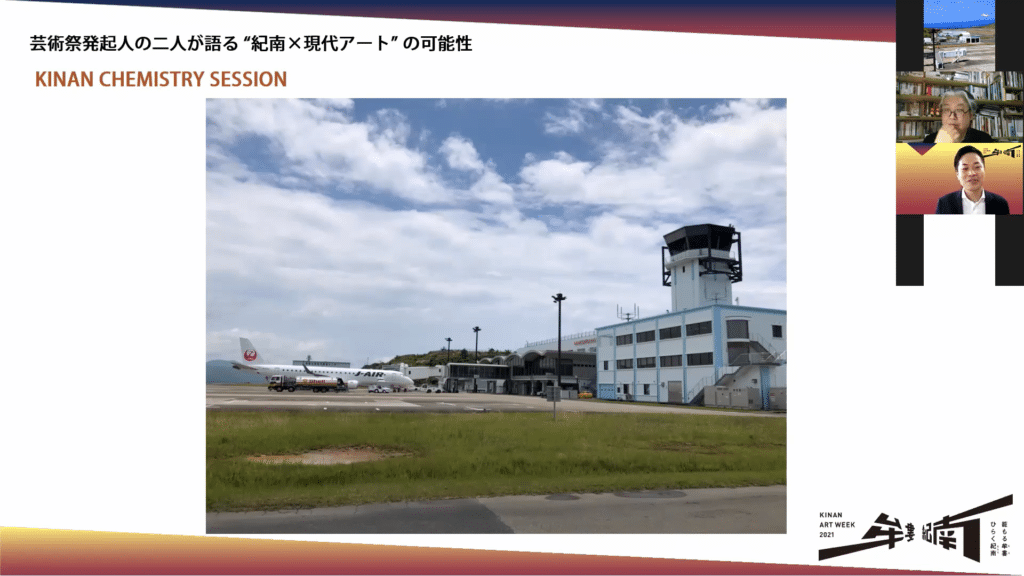
Yabumoto:
Actually, before talking to Nanki-Shirahama Airport, we talked to about 10 of the 100 airports in Japan, including regional airports. The response was: “There is no money in combining art and airports. What’s the point? It would be more rational to increase the number of flights”, which was very frustrating.
However, when I spoke to Nanki Shirahama Airport, they immediately agreed to do it, and in that sense, this may be the first time in Japan that art and an airport have been put into practice, and we hope to accumulate this know-how and export it to other privatized airports. Alternatively, regional airports around the world may be facing similar issues, and we’d like to export the concept from Nanki Shirahama Airport as a valuable infrastructure.
I think it will take 10, 20, or even 30 years, but that will be one of the axes.
Primary and secondary industries unique to the region
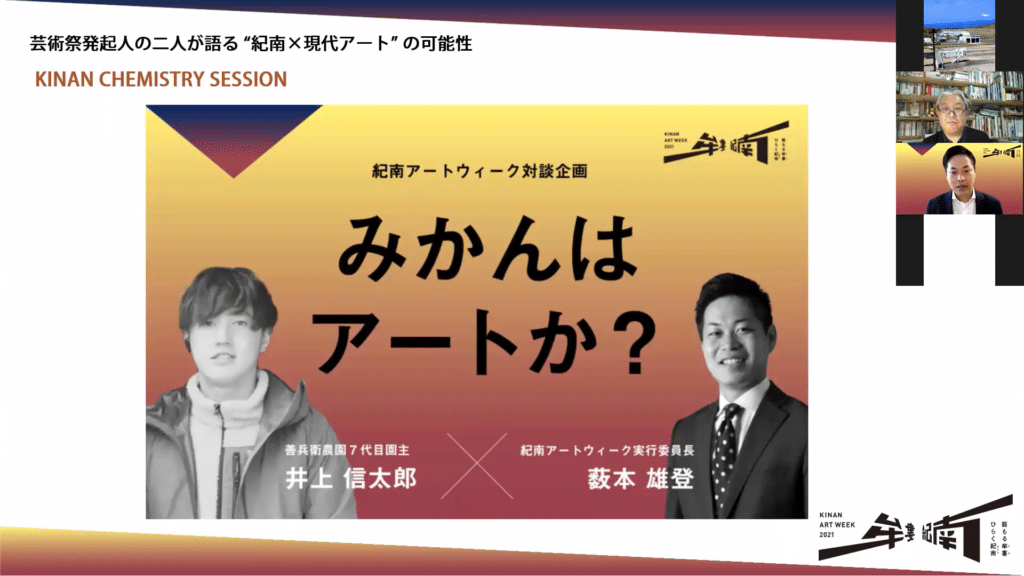
Yabumoto:
The other thing is that I personally think that the primary and secondary industries in the Kinan region are very important.
I think the ‘workcation’ itself is wonderful, and I believe it’s very important to attract the leaders of the the tertiary industry to the Kinan region. However, I believe that competition for attracting workcation will become fierce in the future. I am doing business all over the world, and countries all over the world are reducing their corporate tax rates to attract people to come to their countries, and all countries are doing the same thing, so competition is intensifying.
In view of this, in the long term, we would like to create an opportunity for the leaders of primary and secondary industries, who cannot easily leave Kinan, to gain foreign demand and foreign currency from all over the world, just like the contemporary artists.
Of course, ‘workcation’ is also important, as Rosetsu Nagasawa, who was in Kyoto at the time, exploded with his talent when he came to Kinan, and we believe that Kinan is a great place for “workcation”, “art” and “innovation”.
We are currently working steadily on a series of conversations. Recently, we had a conversation with Mr. Inoue from Zenbee Farm. We’d like to have a dialogue with farmers in the Kinan area, asking them to make use of this Kinan Art Week.
Also, we would like to continue asking fundamental questions, in an artistic way, such as “What is Kinan?”, “What kind of place is Kinan?”, “Why have the people of Kinan grown mikans (mandarin oranges)?”
For the next generation of children
Miyatsu:
We talked about the primary industry, farmers, traditional crops, but also about Mr. Yabumoto, who was wearing a T-shirt, overprinted “I’m a troubled son” at the beginning of the interview. He came back to his hometown after he grew up, and he is also committed to education. Can I ask you about that too?
Yabumoto:
Primary and secondary industries are important, but education is the next most important factor.
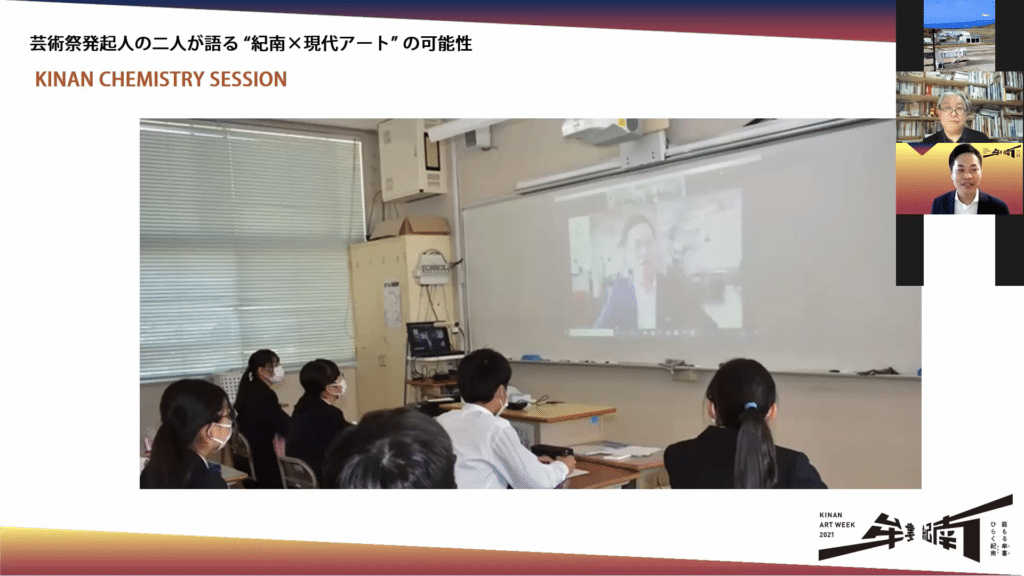
This is a picture of the workshop at Tanabe Junior High School and the next one at Tonda Junior High School, my alma mater. Whenever I have the chance, I would like to have a dialogue with junior high schools , primary schools and high school students in the Kinan area. I am now living abroad, and compared to other global cities in the world such as Tokyo, Singapore and London, Kinan region is clearly shining brightly. I don’t think it’s necessary to go abroad at all to do global work in the future.
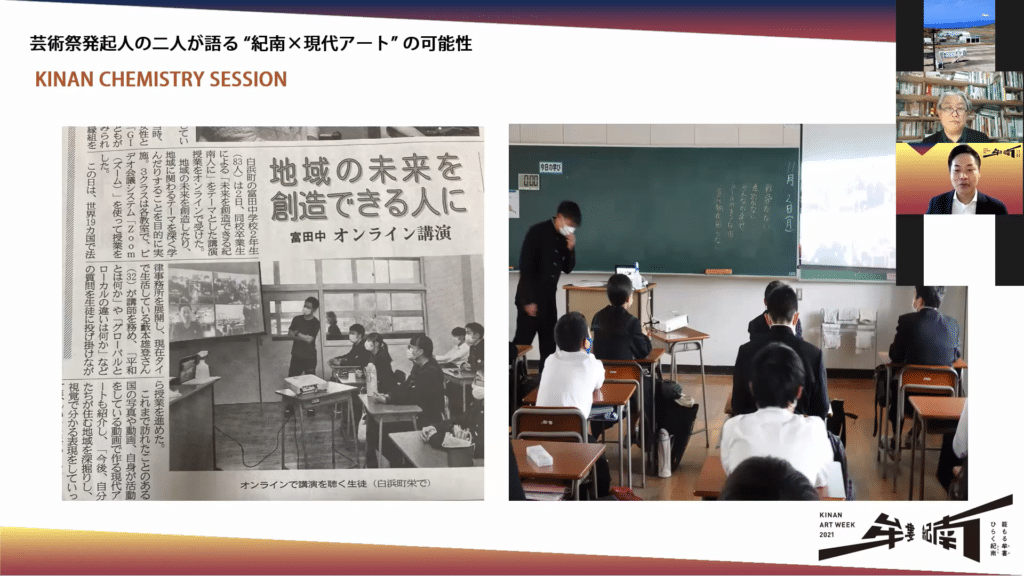
Actually, I’m not good at English either, but I think that the ones that are really valuable will be the things that people will come to you asking “please sell it to me”. While being in Kinan, we just need to introduce our culture and history deeply and profoundly with pride, and I would like to do activities to convey this.
What I have felt in the past 10 years of doing business in Cambodia, Thailand and India is that Japan is clinging on to the success story of domestic demand supremacy, where population and GDP increase. For the time being, it seems that Japan has been able to survive on a business model that says, “please buy a lot of good products at a reasonable price and in large quantities for where the population and GDP increase”. In order to keep doing that, we need plenty of money and human resources.
On the other hand, as long as the people of the country elect their own politicians, they will eventually start to feel uncomfortable with foreigners having a large access to the domestic demand of their country. It is becoming difficult to know whether Japanese companies’ investments, expansions, etc. in Asia can really lead to long-term relationships.
Rather, we hypothesize that the best relationship between Japan and the rest of the world would be to export from Kinan, or from some city or countryside in Japan to the rest of the world.
The importance of values education rather than technology focus

Yabumoto:
In my own business, I feel that there is a problem with the overemphasis on competence and technical skills in education.
I feel that when you go for “competence-technology”, you often create a centrifugal force in a bad way. It is true that the “competence-technology” type is smart, rational and efficient, but I think it tends to be very objective, critical and passive. As a result, they are more likely to be irresponsible and to think that all that matters is what’s good for them.
Of course, this is also important, but when I looked at the world of art, I was strongly attracted by the ‘aesthetic sense’. I think that ideas and philosophies go hand in hand with a sense of beauty. Sometimes I feel that people in the Asian countryside areas are irrational and inefficient, but on the other hand, I feel that they have an ‘axis of self’, however big or small. Such people tend to listen empathetically to others, and have a proactive, holistic nature. For example, when you’re in a restaurant and you see a crying child, it’s amazing how quickly Cambodians take the first step. I think this is a result of having a kind of aesthetic sense of self. I think it’s a result of the values education in the community.
At Kinan Art Week, I would like to make a particular commitment to the education of values such as a sense of beauty.
Exports from a modern port, ‘airport’ and the power of the private sector
Miyatsu:
Thank you very much.
Kinan Art Week has many purposes. One is to export from Nanki-Shirahama Airport, which is a modern ‘port’, some kind of product that is a crystallization of the wisdom, history and climate of Kinan, which is really excellent, or maybe some kind of know-how. So you are hoping to create a synergy with the business that you are currently involved in, and in a way that fits in very well with it, so that it is not just an art week, but also a wonderful export of the unique value of Kinan.
Another big feature is that most of these art festivals are funded with a lot of local tax money or a lot of national tax money. Kinan Art Week is starting from a very small scale in that sense. Yabumoto-san is also investing his own money, and I don’t really have any boundaries as to how much is work and how much is volunteer work. At the moment, we are completely working for this event without pay(laughs).
From the point of view of sustainability, I think we are very different from other art festivals in that we have started with a structure that avoids the problems that arise in each region as a result of investing a lot of ‘taxpayers’ money, and wondering whether it is really appropriate for the region. I don’t think this will be possible anywhere in the future, and I think it is a different kind of movement.

Miyatsu:
Moving on next, where in Kinan will the exhibition take place, and what kind of artists will be chosen?
Regarding artists, we are planning to have international artists and are also planning to have one or more local artists each time. However, there is a need for a chemistry between the artists, their work, the place and the local community, so in the begging is the location. The locations are important. Once the location has been decided, we will announce the artist and the location in stages. We’d like to talk about the places at first.
However, we’d love to talk about the places that have already been decided on, as well as some of the things we eagerly want to do in this event through this session.
Yabumoto-san, please.
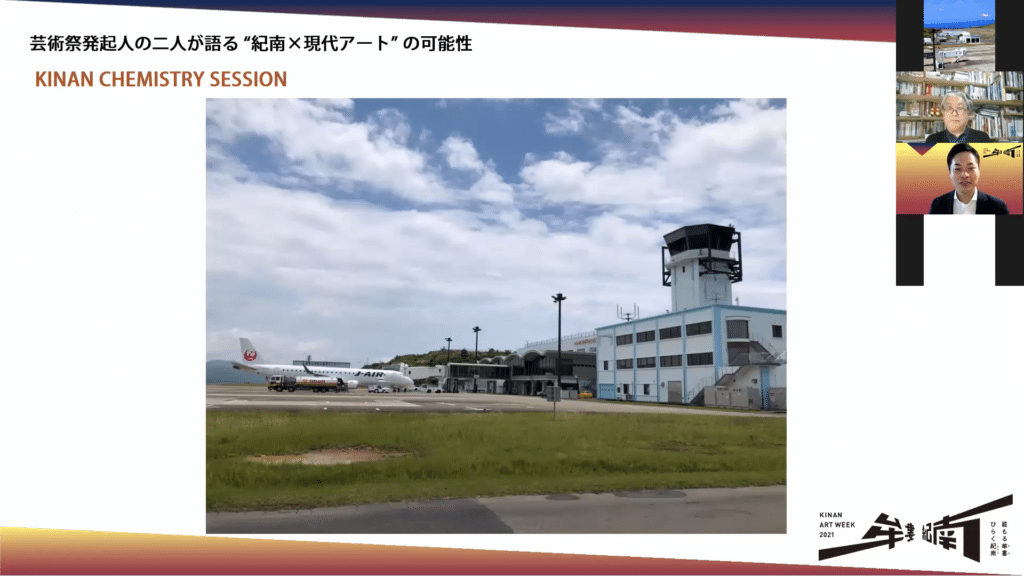
Yabumoto:
Sure, the first place is Nanki Shirahama Airport where we started and the most important symbol of our concept, the culture of ports in our time. We are currently curating, having commenced soon after we obtained the great consent of Nanki Shirahama Airport.

Also, my mother was the first female orca trainer in Japan at Adventure World, so they have been very supportive of us and we would like to exhibit our work there.
They have a wonderful dolphin show and the largest number of pandas in Japan, however we would like to deepen our thinking about the relationship between people and animals at Adventure World.
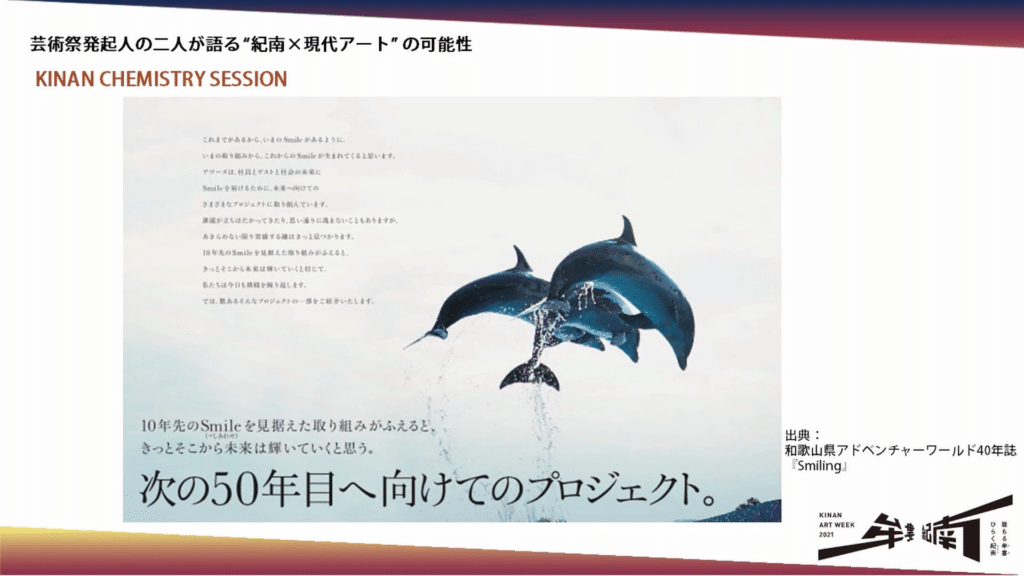
The founder of Adventure World was originally a contractor for Adventure World, undertaking construction work for the developer. When the developer ran into financial difficulties, the company that had been the contractor manfully took over. We hope that we can present a work that is appropriate or the best match for the project, taking into account these historical aspects.
In addition to this, I am very much influenced by “Eastern thought”, Okakura Tenshin and Minakata Kumagusu, whose houses are shown here.
Kumagusu’s thought and the idea that everything in the universe come back together as one, such as the theory of many-unity and oriental thought, are more and more in demand in the world. For example, we would like to hold symposiums or workshops with people who are studying Minakata Kumagusu, or exhibiting works which create a chemical reaction with Minakata Mandala.
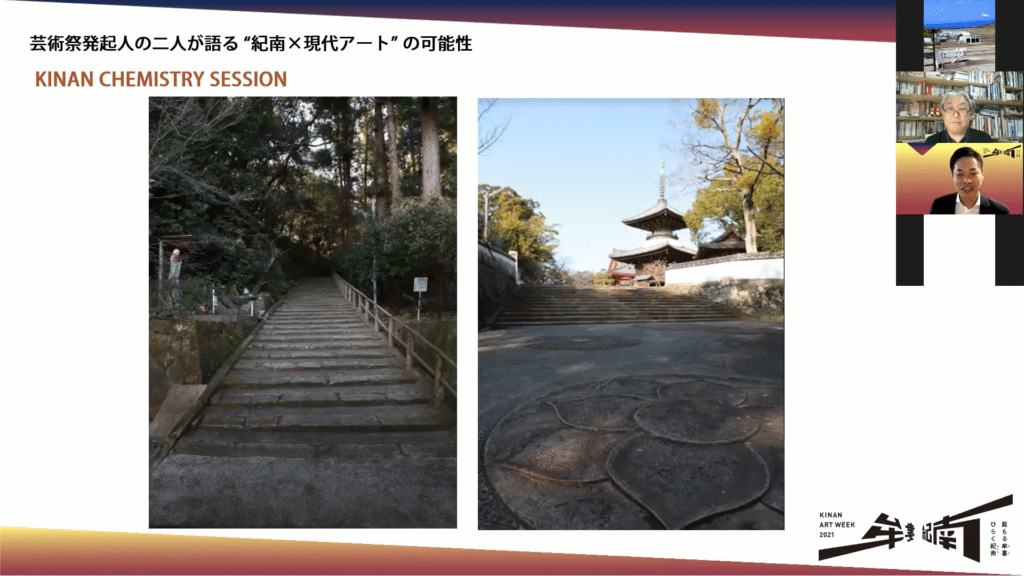
This is Kozanji Temple, where they have a collection of works by Rosetus Nagasawa.
In fact, when I was a member of the baseball team at Tanabe High School, I used to run up and down the stairs here, and in that sense, I owe a lot to the temple, so I’d like to show my gratitude in many ways…(laughs)
As we talked with the chief priest, not only about Buddhism but also many other aspects of Kozanji Temple, they are represented. Kumasugu’s grave is also here. Kozenji-temple was originally a shell mound. I would like to go back over 5000 years of history and explore the possibility of a new exhibition in this context.
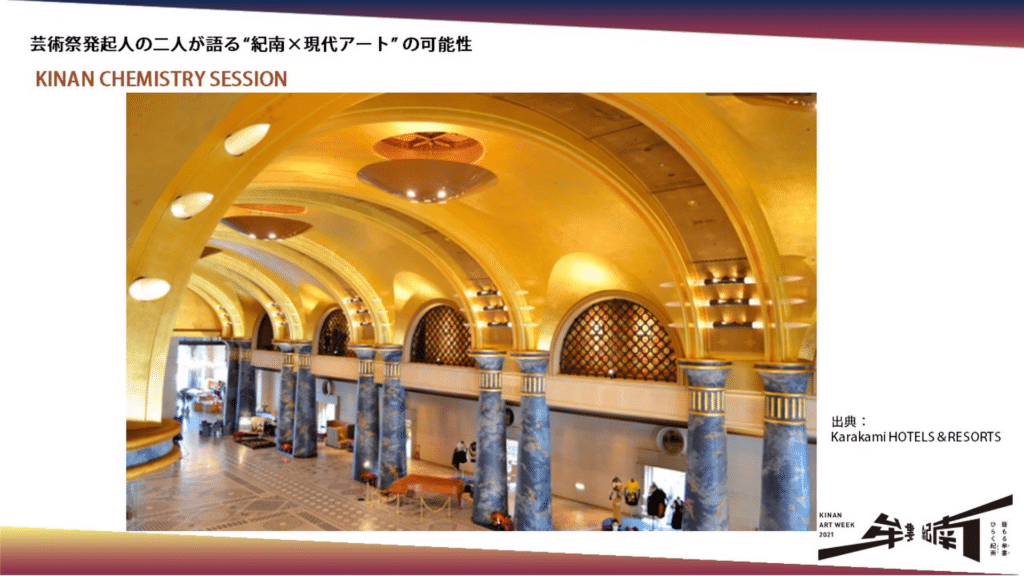
And lastly, sure enough, it’s the Hotel Kawakyu. It has the world’s highest gold leaf ceiling, registered in the Guinness Book of Records. I hope we can collaborate with them in some way.
Mr. Miyatsu, do you have anything to add?
Miyatus:
We have not yet decided on details about the location of Nanki Shirahama Airport and Adventure World, like where in the airport or Adventure World and what to show there, but they have agreed to be our exhibition venues.
As for the other venues, Mr.Yabumoto and I are in the middle of eagerly making request to them with our dreams of what we would like to do and what we can do. We hope to be able to exhibit in as many places as possible.
As we have said, not just to show the work, but to give people an experience of the work that can only be seen there by combining the place and the work. Through these ideas, we are now preparing this event, including negotiations.
Morishige:
Now, the time has come, so we would like to conclude. One of the participants, Mr. Itani, the mayor of Shirahama-town, has made a comment:
“I’m really looking forward to this event and am excited about it. Today’s session was brilliant and easy to understand. I would like to work on this in the wider Kinan area.”
Miyatsu:
Thank you very much for your time today.
Yabumoto:
Thank you very much. I really appreciate your time today.
.

